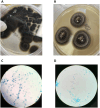Successful Treatment of Lomentospora Prolificans Infection Following Allogeneic Hematopoietic Stem Cell Transplantation: A Case Report and Literature Review
- PMID: 40718369
- PMCID: PMC12297014
- DOI: 10.2147/IDR.S529984
Successful Treatment of Lomentospora Prolificans Infection Following Allogeneic Hematopoietic Stem Cell Transplantation: A Case Report and Literature Review
Abstract
Lomentospora prolificans is an opportunistic fungal pathogen known for its intrinsic multidrug resistance. This pathogen poses a significant challenge in immunocompromised individuals, particularly patients with hematologic malignancies. We present a case of a 27-year-old male diagnosed with adverse-risk acute myeloid leukemia (AML) who developed pulmonary Lomentospora prolificans infection following therapy for positive measurable residual disease (MRD) and severe chronic graft-versus-host disease (cGVHD) after allogeneic hematopoietic stem cell transplantation (allo-HSCT). Despite the pathogen's multidrug resistance and the typically poor prognosis associated with invasive infections in immunocompromised hosts, the patient achieved sustained remission and favorable outcome. This study systematically reviews Lomentospora prolificans infections following HSCT by analyzing 37 reported cases from 24 studies identified through a PubMed search. The majority of cases had acute myeloid leukemia as the most common underlying disease. Disseminated infections were predominant (83.8%), with frequent pulmonary and central nervous system involvement. Antifungal treatment strategies largely involved combination therapy, yet outcomes remained poor, with an overall survival rate of only 13.5%. These findings highlight the critical need for novel therapeutic approaches and early intervention strategies to improve patient outcomes.
Keywords: Lomentospora prolificans; hematopoietic stem cell transplantation; terbinafine; voriconazole.
© 2025 Yang et al.
Conflict of interest statement
The author(s) report no conflicts of interest in this work.
Figures



Similar articles
-
[Lomentospora prolificans Fungemia in a Patient With T-Cell Large Granular Leukemia: A Rare Pathogen in Türkiye].Mikrobiyol Bul. 2024 Apr;58(2):209-219. doi: 10.5578/mb.202498145. Mikrobiyol Bul. 2024. PMID: 38676587 Turkish.
-
First-line allogeneic hematopoietic stem cell transplantation of HLA-matched sibling donors compared with first-line ciclosporin and/or antithymocyte or antilymphocyte globulin for acquired severe aplastic anemia.Cochrane Database Syst Rev. 2013 Jul 23;2013(7):CD006407. doi: 10.1002/14651858.CD006407.pub2. Cochrane Database Syst Rev. 2013. PMID: 23881658 Free PMC article.
-
Bone marrow versus peripheral blood allogeneic haematopoietic stem cell transplantation for haematological malignancies in adults.Cochrane Database Syst Rev. 2024 Nov 7;11(11):CD010189. doi: 10.1002/14651858.CD010189.pub3. Cochrane Database Syst Rev. 2024. PMID: 39508306
-
Bone marrow versus peripheral blood allogeneic haematopoietic stem cell transplantation for haematological malignancies in adults.Cochrane Database Syst Rev. 2014 Apr 20;2014(4):CD010189. doi: 10.1002/14651858.CD010189.pub2. Cochrane Database Syst Rev. 2014. Update in: Cochrane Database Syst Rev. 2024 Nov 7;11:CD010189. doi: 10.1002/14651858.CD010189.pub3. PMID: 24748537 Free PMC article. Updated.
-
Second allogeneic stem cell transplantation using different donors as the salvage treatment for acute myeloid leukemia relapsed after allogeneic hematopoietic stem cell transplantation.Clin Exp Med. 2025 Jul 15;25(1):249. doi: 10.1007/s10238-025-01787-9. Clin Exp Med. 2025. PMID: 40660037 Free PMC article.
References
-
- Gavriilaki E, Evangelidis P, Kotsiou N, et al. Antifungal prescription and stewardship in hematology and hematopoietic stem cell transplantation units worldwide: an international survey of EHA-SWG Infections in Hematology. Bone Marrow Transplant. 2025;60(5):729–732. doi: 10.1038/s41409-025-02545-x - DOI - PubMed
-
- Gavriilaki E, Dolgyras P, Dimou-Mpesikli S, et al. Risk factors, prevalence, and outcomes of invasive fungal disease post hematopoietic cell transplantation and cellular therapies: a retrospective monocenter real-life analysis. Cancers. 2023;15(13):3529. doi: 10.3390/cancers15133529 - DOI - PMC - PubMed
Publication types
LinkOut - more resources
Full Text Sources

